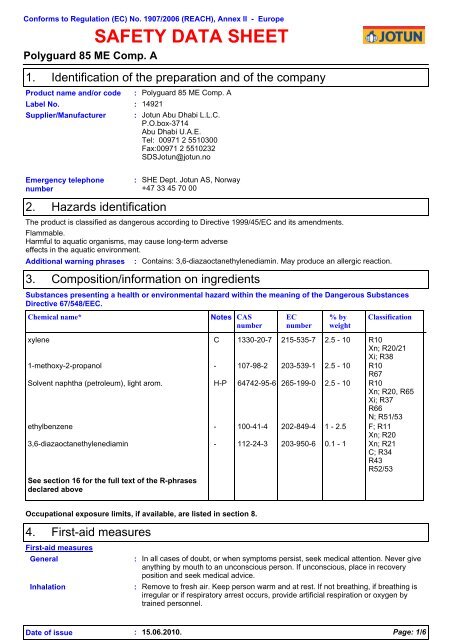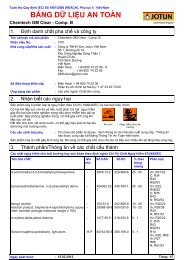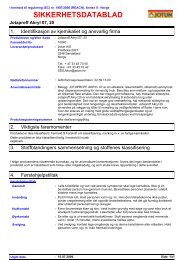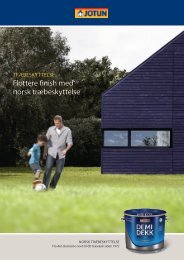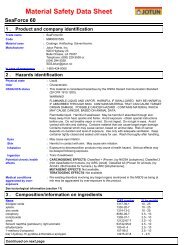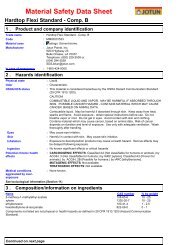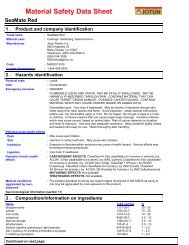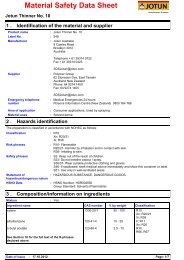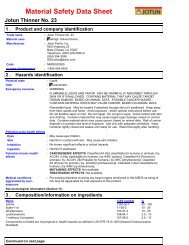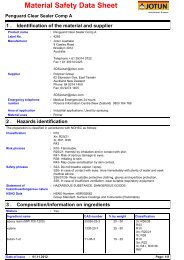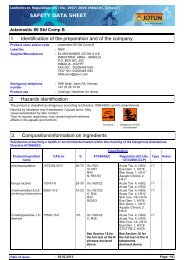Polyguard 85 ME Comp. A - Jotun
Polyguard 85 ME Comp. A - Jotun
Polyguard 85 ME Comp. A - Jotun
- No tags were found...
You also want an ePaper? Increase the reach of your titles
YUMPU automatically turns print PDFs into web optimized ePapers that Google loves.
<strong>Polyguard</strong> <strong>85</strong> <strong>ME</strong> <strong>Comp</strong>. ASkin contactEye contactIngestion:::Remove contaminated clothing and shoes. Wash skin thoroughly with soap andwater or use recognised skin cleanser. Do NOT use solvents or thinners.Check for and remove any contact lenses. Immediately flush eyes with running waterfor at least 15 minutes, keeping eyelids open.If swallowed, seek medical advice immediately and show the container or label.Keep person warm and at rest. Do not induce vomiting.5.Fire-fighting measuresExtinguishing media :Extinguishing media not tobe usedRecommendationsPersonal precautionsRecommended: alcohol-resistant foam, CO 2, powders, water spray.: Do not use water jet.6. Accidental release measures: Fire will produce dense black smoke. Exposure to decomposition products maycause a health hazard. Appropriate breathing apparatus may be required.Cool closed containers exposed to fire with water. Do not release runoff from fire todrains or watercourses.:Exclude sources of ignition and ventilate the area. Avoid breathing vapour or mist.Refer to protective measures listed in sections 7 and 8. Contain and collect spillagewith non-combustible, absorbent material e.g. sand, earth, vermiculite ordiatomaceous earth and place in container for disposal according to local regulations(see section 13).Spill: Preferably clean with a detergent. Avoid using solvents.Note: see section 8 for personal protective equipment and section 13 for waste disposal.7.Handling and storageHandlingStorage::Vapours are heavier than air and may spread along floors. Vapours may formexplosive mixtures with air. Prevent the creation of flammable or explosiveconcentrations of vapours in air and avoid vapour concentrations higher than theoccupational exposure limits.In addition, the product should only be used in areas from which all naked lights andother sources of ignition have been excluded. Electrical equipment should beprotected to the appropriate standard.To dissipate static electricity during transfer, earth drum and connect to receivingcontainer with bonding strap. Operators should wear antistatic footwear and clothingand floors should be of the conducting type.Keep container tightly closed. Keep away from heat, sparks and flame. No sparkingtools should be used.Avoid contact with skin and eyes. Avoid the inhalation of dust, particulates, spray ormist arising from the application of this preparation. Avoid inhalation of dust fromsanding.Eating, drinking and smoking should be prohibited in areas where this material ishandled, stored and processed.Put on appropriate personal protective equipment (see section 8).Never use pressure to empty. Container is not a pressure vessel.Always keep in containers made from the same material as the original one.<strong>Comp</strong>ly with the health and safety at work laws.When operators, whether spraying or not, have to work inside the spray booth,ventilation is unlikely to be sufficient to control particulates and solvent vapour in allcases. In such circumstances they should wear a compressed air-fed respiratorduring the spraying process and until such time as the particulates and solventvapour concentration has fallen below the exposure limits.Store in accordance with local regulations. Observe label precautions. Store in a dry,cool and well-ventilated area. Keep away from heat and direct sunlight.Keep away from sources of ignition. Keep away from: oxidising agents, strongalkalis, strong acids.No smoking. Prevent unauthorised access. Containers that have been opened mustbe carefully resealed and kept upright to prevent leakage. Do not empty into drains.Date of issue : 15.06.2010.Page: 2/6
<strong>Polyguard</strong> <strong>85</strong> <strong>ME</strong> <strong>Comp</strong>. A8. Exposure controls/personal protectionEngineering measuresIngredient namexylene1-methoxy-2-propanolSolvent naphtha (petroleum), lightarom.ethylbenzene:Provide adequate ventilation. Where reasonably practicable, this should be achievedby the use of local exhaust ventilation and good general extraction. If these are notsufficient to maintain concentrations of particulates and solvent vapours below theOEL, suitable respiratory protection must be worn.Occupational exposure limitsEU OEL (Europe, 12/2009). Absorbed through skin. Notes: listof indicative occupational exposure limit valuesSTEL: 442 mg/m³ 15 minute(s).STEL: 100 ppm 15 minute(s).TWA: 221 mg/m³ 8 hour(s).TWA: 50 ppm 8 hour(s).EU OEL (Europe, 12/2009). Absorbed through skin. Notes: listof indicative occupational exposure limit valuesSTEL: 568 mg/m³ 15 minute(s).STEL: 150 ppm 15 minute(s).TWA: 375 mg/m³ 8 hour(s).TWA: 100 ppm 8 hour(s).EU OEL (Europe, 6/2000).TWA: 100 mg/m³ 8 hour(s). Form: All formsTWA: 20 ppm 8 hour(s). Form: All formsEU OEL (Europe, 4/2006). Absorbed through skin. Notes:IndicativeLimit value: 100 ppm 8 hour(s).Limit value: 442 mg/m³ 8 hour(s).Short term limit value: 200 ppm 15 minute(s).Short term limit value: 884 mg/m³ 15 minute(s).Personal protective equipmentRespiratory system :Skin and body:Hands:If workers are exposed to concentrations above the exposure limit, they must useappropriate, certified respirators. Use respiratory mask with charcoal and dust filterwhen spraying this product.(as filter combination A2-P2). In confined spaces, usecompressed-air or fresh-air respiratory equipment. When use of roller or brush,consider use of charcoalfilter.Personnel should wear antistatic clothing made of natural fibres or of hightemperature-resistantsynthetic fibres.Wear suitable gloves.Eyes9.:Not recommended, gloves(breakthrough time) < 1 hour: neoprene, butyl rubber,PVCRecommended, gloves(breakthrough time) > 8 hours: 4H, Teflon, nitrile rubberFor right choice of glove materials, with focus on chemical resistance and time ofpenetration, seek advice by the supplier of chemical resistant gloves.The user must check that the final choice of type of glove selected for handling thisproduct is the most appropriate and takes into account the particular conditions ofuse, as included in the user's risk assessment.Physical and chemical propertiesPhysical state: Liquid.Odour: Characteristic.Colour: VariousFlash point: Closed cup: 30°C (86°F)Density : 1 g/cm 3Use safety eyewear designed to protect against splash of liquids.Explosion limits : 1.1 - 13.7%Solubility: Insoluble in the following materials: cold water and hot water.Date of issue : 15.06.2010.Page: 3/6
<strong>Polyguard</strong> <strong>85</strong> <strong>ME</strong> <strong>Comp</strong>. A10.Stability and reactivityStable under recommended storage and handling conditions (see section 7).Hazardous decomposition products: carbon monoxide, carbon dioxide, smoke, oxides of nitrogen.Keep away from the following materials to prevent strong exothermic reactions: oxidising agents, strong alkalis, strongacids.11.Toxicological informationThere is no data available on the preparation itself. The preparation has been assessed following the conventionalmethod of the Dangerous Preparations Directive 1999/45/EC and classified for toxicological hazards accordingly. Seesections 2 and 15 for details.Exposure to component solvent vapour concentrations in excess of the stated occupational exposure limit may result inadverse health effects such as mucous membrane and respiratory system irritation and adverse effects on the kidneys,liver and central nervous system. Solvents may cause some of the above effects by absorption through the skin.Symptoms and signs include headache, dizziness, fatigue, muscular weakness, drowsiness and, in extreme cases, lossof consciousness. Repeated or prolonged contact with the preparation may cause removal of natural fat from the skin,resulting in non-allergic contact dermatitis and absorption through the skin. If splashed in the eyes, the liquid may causeirritation and reversible damage. Swallowing may cause nausea, diarrhoea, vomiting, gastro-intestinal irritation andchemical pneumonia.Contains: 3,6-diazaoctanethylenediamin. May produce an allergic reaction.12.Ecological informationThere is no data available on the preparation itself.Do not allow to enter drains or watercourses.The preparation has been assessed following the conventional method of the Dangerous Preparations Directive1999/45/EC and is classified for eco-toxicological properties accordingly. See Sections 3 and 15 for details.Aquatic ecotoxicityProduct/ingredient name Test ResultSpecies Exposurexylene Mortality Acute LC50 12000 to Fish - Bluegill 96 hours16114 ug/L Fresh water - Lepomismacrochirus -1,1 gSolvent naphtha (petroleum), light arom. - Acute EC50
<strong>Polyguard</strong> <strong>85</strong> <strong>ME</strong> <strong>Comp</strong>. A13.Disposal considerationsDo not allow to enter drains or watercourses. Material and/or container must be disposed of as hazardous waste.European waste catalogue(EWC):08 01 11* waste paint and varnish containing organic solvents or other dangeroussubstances. If this product is mixed with other wastes, this code may no longer apply.If mixed with other wastes, the appropriate code should be assigned. For furtherinformation, contact your local waste authority.14.Transport informationTransport within user’s premises: always transport in closed containers that are upright and secure. Ensure thatpersons transporting the product know what to do in the event of an accident or spillage.International transport regulationsProper shipping nameUN Number::Paint.1263Class : 3Packing group: IIILabel:Additional informationADR / RIDIMDG: Tunnel restriction code: (D/E)Hazard identification number: 30Special provisions: 640EADR/RID: Viscous substance. Not restricted, ref. chapter 2.2.3.1.5 (applicable toreceptacles < 450 litre capacity).: Emergency schedules (EmS): F-E, S-EMarine pollutant: No.IMDG: Viscous substance. Transport in accordance with paragraph 2.3.2.5(applicable to receptacles < 30 litre capacity).Transport in accordance with ADR/RID, IMDG/IMO and ICAO/IATA and national regulation.15.Regulatory informationEU regulationsRisk phrasesSafety phrasesAdditional warningphrasesRestrictions on theMarketing and UseDirectiveIndustrial use: The product is classified and labelled for supply in accordance with the Directive1999/45/EC as follows:: R10- Flammable.R52/53- Harmful to aquatic organisms, may cause long-term adverse effects in theaquatic environment.:S23- Do not breathe vapour / spray.: Contains: 3,6-diazaoctanethylenediamin. May produce an allergic reaction.:Restricted to professional users.: The information contained in this safety data sheet does not constitute the user’sown assessment of workplace risks, as required by other health and safetylegislation. The provisions of the national health and safety at work regulations applyto the use of this product at work.16.Other informationCEPE Classification : 1Date of issue : 15.06.2010.Page: 5/6
<strong>Polyguard</strong> <strong>85</strong> <strong>ME</strong> <strong>Comp</strong>. AFull text of R-phrasesreferred to in sections 2 and3 - Europe:R11- Highly flammable.R10- Flammable.R20- Harmful by inhalation.R21- Harmful in contact with skin.R20/21- Harmful by inhalation and in contact with skin.R65- Harmful: may cause lung damage if swallowed.R34- Causes burns.R37- Irritating to respiratory system.R38- Irritating to skin.R43- May cause sensitisation by skin contact.R66- Repeated exposure may cause skin dryness or cracking.R67- Vapours may cause drowsiness and dizziness.R51/53- Toxic to aquatic organisms, may cause long-term adverse effects in theaquatic environment.R52/53- Harmful to aquatic organisms, may cause long-term adverse effects in theaquatic environment.This Safety Data Sheet is prepared in accordance with Annex II to Regulation (EC) No 1907/2006.Date of issue : 15.06.2010.Version: 1.03Indicates information that has changed from previously issued version.Notice to readerThe information in this SDS is based on the present state of our knowledge and on current laws. The productis not to be used for purposes other than those specified under section 1 without first obtaining writtenhandling instructions. It is always the responsibility of the user to take all necessary steps to fulfil thedemands set out in the local rules and legislation. The information in this SDS is meant to be a description ofthe safety requirements for our product. It is not to be considered a guarantee of the product's properties.Date of issue : 15.06.2010.Page: 6/6


